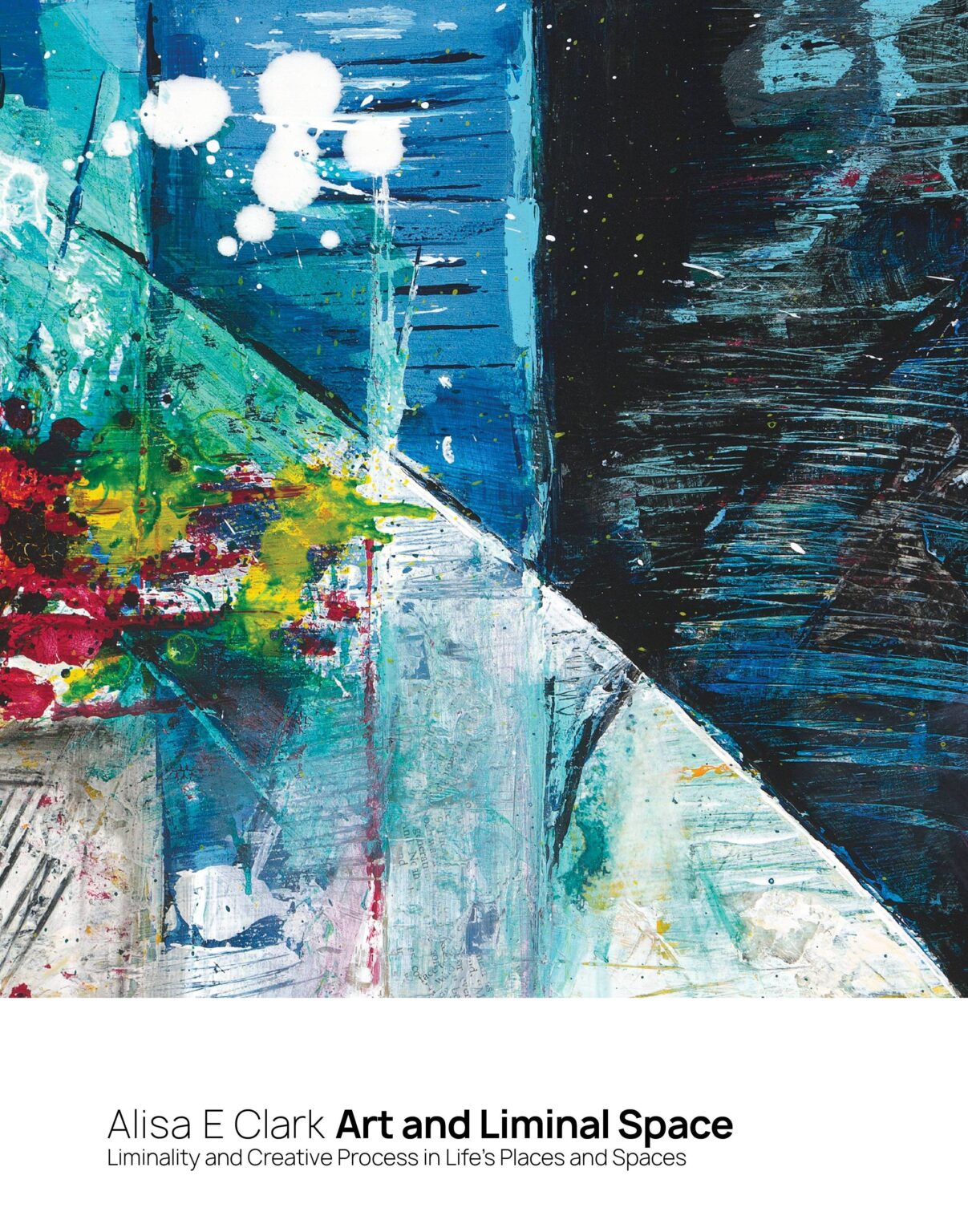
Inspiration for Creative Journaling
“Not all those who wander are lost.” ― J.R.R. Tolkien
Keep a Creative Journal
Your journey can be better understood by exploring it inside a creative journal. Though words and images, you can uncover themes within your story, experience the spiritual benefits of artistic exploration, express yourself creatively, and find hope.
My 3D Art Journal
I painted through my journey. I have included Yesterday, Right Now, and Tomorrow all at once. This piece spins and the flaps and doors open and close. This lets the viewer move through space, time, and place. Working in 3D creates an awareness of time shifting and changing: a liminal experience. Working in 3D also allowed me to uncover themes in my story. A journal is wonderful for exploring our journey, but we can step outside the box and share our story in other ways. “My Journey: An Altered Book” is a 3D journal. What creative ways can you share your “journey on canvas?”
Basic Suggestions for Journaling
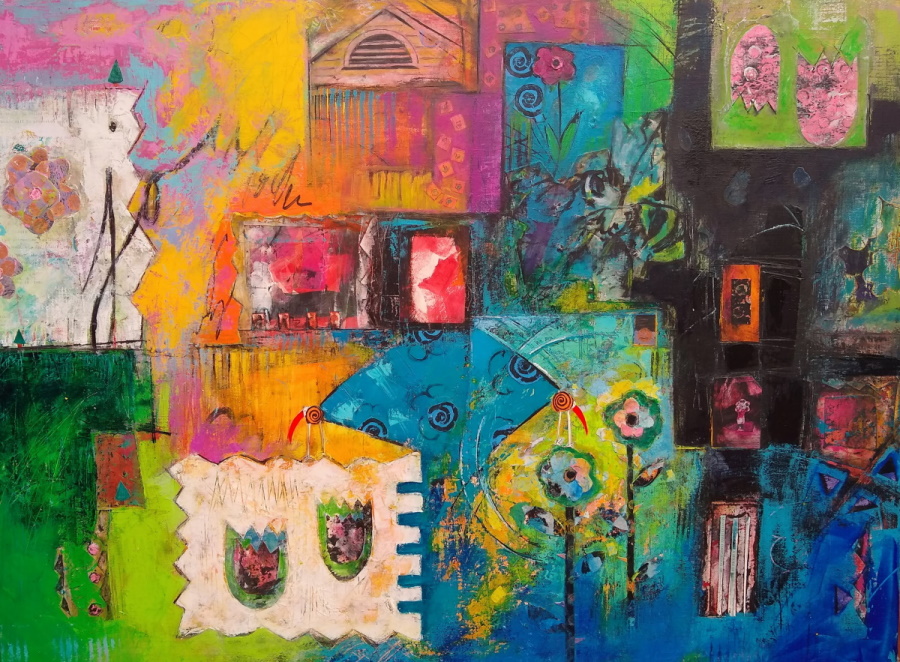
There are many benefits to keeping a personal journal. Journal writing can be a simple tool that releases new understanding and new hope. Writing in a journal need not be complicated or challenging. A few basic suggestions can help the novice journaler launch their first personal journal
Journal writing inside a personal journal is an opportunity to record life experiences. This can be done by sharing lessons you have learned or listing observations for the day. You can write down quotations that inspire you, passages from books that resonate with you, or prayers that center you. Make a bulleted list of the day’s events, draw a map of your travels or write down a few meaningful words someone shared with you. Draw a picture, write a confession or share your anger through a few choice words. Do whatever you want. A personal journal is personal. It’s nobody’s business but yours: no rules, no regulations and no expectations. Finally, you have a place where you can do whatever you want and nobody can stop you!
Some people like to have a journal for a specific purpose. For example, a journal could solely be a book of lists, a series of letters or a record of daily events. You can have several journals you are keeping at once: each for a different purpose. Keep track of what you hear God saying to you inside a journal: a simple paragraph each day that seeks to hear His voice. Keep track of valuable insights found through daily reading, vent your frustrations or write down your worries. Keep a Worry Journal, a book of quotations, or an Anger Log. Use index tabs to divide a binder into sections: one section for each journaling purpose. Now you have one place to keep all your journals!
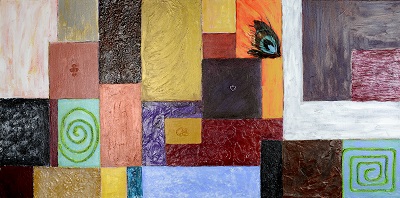
Artist Guillermo Kuitca takes discarded canvases and stretches them over a round table. These tables become daily diaries upon which he captures his daily musings and travels. Phone numbers, lists, schedules, appointments, quotes, traces of objects that sat on the canvas and email addresses cover the canvas top to create a personal diary. Guillermo teachers us that journal writing can take a multitude of forms and serve a multitude of purposes. He encourages us to think outside the box and find a journal format that works for us.
Think Outside the Box
If you are a novice journaler, remember that a journal is a place for you to decide how you will keep record of your own story. Consider finding a journaling tool that works for you. From diaries, to notebooks to canvas covered kitchen tables, the formats are endless. Pick a venue for documentation and expression that fits your personality and your lifestyle. Think outside the box, keep an open mind when considering the possibilities. Pick a journal that matches your personality and your needs. Then, pick up a pen and share your story.
Thoughts on Starting a Journal
Very often, the first step of journaling is figuring out what matters in your life and jotting it down. Everyone’s journaling process is different. People’s experience with journaling can also vary greatly. Be prepared to find your own way. With that said, help can be found through discovering the ways other people have journeyed inside their journal.
I chose to start journaling by writing about my earliest memories. Later, I decided on which memories to include and leave out. I had to make decisions that required a lot of searching and pondering. I did a lot of praying, too. I wanted my story to matter: to make a difference. My journal gave me a place to explore all my thoughts, hopes, and dreams for my story.
Let It Matter
My ordinary life-
Let it not be a meaningless journey-
Where only bad is found where there is also much good-
In which happiness has been lost and forgotten-
Memories are only of pain, sadness and loss-
Instead,
Let what is good shine in the dark places-
What was right silence what is best forgotten-
May truth call into the light what heals, gives joy and brings life-
Redeem my journey, Lord.
Please.
Let it matter.
Sharing My Journey
I remember that I was very sheltered as a child. My childhood home was an old farmhouse surrounded by two acres of remarkable beauty. Our yard was filled with green grass, gigantic pine trees, tons of wildlife and lots of fruit to pick and eat. Our home was centered within ten acres of forest that separated us from the outside world. It was our own little paradise.

I recall saying prayers before dinner. That was the only time my family made any reference to God. Recognizing and enjoying beauty was my family’s religion. My dad was a scientist, so it was natural for him to investigate things. It was also natural for him to share his discoveries with us. He was often the first to notice the crocuses budding in the spring. He’d snip a few and bring them inside. He’d place them in a little glass cup with water and show them off in the middle of the kitchen table. This was just one way he drew our attention to the beauty around us. We were surrounded by incredible beauty, so Dad didn’t need to look far to find something wondrous to share. What he shared with me became a part of my palette.
Sharing Your Journey
Consider the variety of journals that you can choose from. Maybe a sketchbook would suit your personality? Perhaps you’d like to choose a 3 ring binder that you can fill with lined paper, pockets, and blank paper. Check out the journal options in the scrapbooking aisle, the local bookstore, and on the shelves at some of the places you regularly shop. Load up on some good office supplies and simple art supplies. Some highlighters, colored pencils, red marking pens, erasable pens, and markers can help you along as you journal. Make some selections that get you really excited about the spiritual journey you are about to embark on. Your journey is worth the investment!
Journal About Hope
Hope matters to me. When I wrote my story I tried to choose memories that resonated with hope. This didn’t mean that I always chose happy memories. It did mean that I cared, and still do care, about finding the light in the darkness: finding that light brings me hope. In my journal, I always made a point to write about the hope: especially when I was exploring things that left me feeling hopeless.

Hope is my inspiration. Simply sharing stories with a good friend over a cup of coffee has power. A vignette from your life can become proof, for someone else, that they are not alone. Blog postings, Facebook Pages, Instagram, and posts to Twitter can make a difference. Joining a support group can become support for you and someone else. Don’t limit the opportunities you have to share! Before you know it, your story will emerge. This process of sharing the hope of a story can begin inside your journal.
Sharing My Journey

In my house there are a lot of big rugs with fancy designs on them. The rugs are worn, and they’re prickly when you sit on them. The house is cold, so I’m sitting on a pretty, prickly rug instead of on the floor. All around me are designs: designs on the rugs, designs on the bedspreads, and designs on the wallpaper. My mom loves designs, patterns and colors. Some of the walls in our house don’t have designs, but they’re painted funny colors. My dining room has pink walls and a big fancy carpet that’s really big. My mom likes to decorate and she likes to have parties. When people come to visit they talk about my fancy house. They like the big dining room with the pink walls and they like my mom.
I want to make a picture. I draw a vase. I put flowers on the vase. I draw a gray flower, a green flower, a blue flower and an orange flower. The flowers make a nice design on the vase like the designs I see around me. I color the walls behind the vase a funny color. I choose orange. Orange goes good with the fancy vase with the flower designs. I like it. I think my mom will like it too.
I want to make a picture. I draw a vase. I put flowers on the vase. I draw a gray flower, a green flower, a blue flower and an orange flower. The flowers make a nice design on the vase like the designs I see around me. I color the walls behind the vase a funny color. I choose orange. Orange goes good with the fancy vase with the flower designs. I like it. I think my mom will like it too.
Sharing Your Journey
Where does one begin inside their journal? I’d begin with believing that there’s hope: hope that your can tell your story, hope that someone will listen and be encouraged, and hope that your story will bring you hope. With hope as your inspiration, you can more easily begin the nitty gritty of organizing your spiritual autobiography. Here’s how I started on my “nitty gritty” and found a way to begin writing that worked for me:
I began by sifting through old photographs, old memories, and old art work. I sifted through my childhood. As I sifted, I looked for threads, or commonalities, that weaved their way through my life. I discovered that much of what I believed about God took root when I was just a small child. I wrote down what I discovered in my journal. I picked the most vivid memories and I put them to words. I didn’t worry about how each memory had a part in my story. I just wrote and let the “parts” reveal themselves.
Looking back on my journal entries, I am satisfied with the sifting process that I used. It suited me and it helped me make sense of my past. Consider what process for “remembering” will suit you. Maybe you want to list memories in your journal? Then you will have a place to go back to, so you can decide which memories you’d like to further explore. Perhaps, you want to start with your favorite early memories? Maybe you’d like to create some sketches that connect you with your early years? What images would you include in such a sketch? Give yourself time to sift through your early years. Give yourself time to decide what has always mattered most to you.
Use your journal for the sifting process so you can reflect, organize, and connect your past experiences with your present spirituality. Let your journal become a place to explore and document your past, so that you can find the pieces that matter. Let your journal become a place to make sense out of who you have become and the ways your past is a part of who you are today. Regardless of your approach, or beliefs, your journal can be the place for you to begin to find a voice for your story.
Use Your Journal to Remember
My journal includes my childhood memories. I can’t separate the stories of my past from my story today. Everything that’s happened to me shapes my story today. I go back as far into the past as I can. I search my earliest recollections to figure out where my story began.

My story includes certain people and memories from my childhood. I remember how, in junior high school, I made a new friend named Maureen. Maureen’s parents liked me. Maureen’s mom took me under her wing. She became my spiritual ma ma. My parents didn’t mind if I went to church, but they didn’t want to go themselves. My new friend’s mom and dad picked me up at my house on their way to St. Boniface some Sunday mornings. I liked to go to church with them. It’s was a treat because I got to decide if I wanted to go. No one made me go to mass. I went because I was curious.
Maureen’s mom talked to me about God when we sat around her kitchen table. She read her Bible all the time and told me that Jesus was her friend. I didn’t know how she got to know Jesus like that, but I hoped Mrs. Clark could help me know Him like that too. Going to church with Maureen’s family seemed like a good place to try and find Him, so I was glad they all let me tag along.
Tagging along with Maureen’s family changed my spiritual life. It wasn’t just the action of going to church that changed my spiritual life. Hanging out with Mrs. Clark had a huge impact on me. Being with a family that was concerned with spiritual things had a huge impact on me. It was the relationships, not the act of church going, that really made the difference. Maureen’s house was full of people who made me want to know more about my spiritual story.
My good childhood memories, and not so good memories, are mostly connected to relationships. When writing my story, I had to consider how childhood memories and childhood relationships impacted my story. As you reflect on your journey consider the people who impacted you and changed you. How did they change the direction of your journey or help you emerge as the person you are today?
Sharing My Journey
Returning home from my date felt odd. It was very late. I quietly slinked in the back door. I thought my dad might tell what had transpired by the look on my face and the hour of my return. I was a little embarrassed and hoped to dodge him. Dad was waiting, though. He was patiently waiting my return. I found him nodding off slightly in his rocking chair in the T.V. room. He smiled and greeted me. Then he went off to bed. I noted the generosity in his readiness to let me grow up. I noted his willingness to let me face the perils and perks of becoming a woman. “He knows,” I thought. “He knows that I’ve been kissed.”

I went to bed excited and relieved. When I woke up I actually woke up refreshed. I noted that I actually slept through the night. I recalled that it had been two weeks, maybe more, since I had slept through the night. I stretched, yawned and crawled out of bed to face a new and more hopeful day.
I paused, on my way to the bathroom, to look out the window. I noted that the view was cause for pause. It was beautiful. I saw the 6 big apple trees in my backyard. They were full of green leaves and apples. I saw big open spaces full of sunshine, green grass and bright yellow dandelions. There were apples falling to the ground everywhere. A deer and some rabbits had come to eat them. What I saw reminded me that there was a God because what I saw was so fantastic. I knew it had to have been made by an awesome God. “I like my home,” I thought. “There’s no place else like it.” I knew that one day I’d have to live someplace else. I saw that I couldn’t live like a child, in my parent’s home, forever. “I’m growing up,” I said to myself. “I wish I could grow up but still live in this beautiful place.”
I try to make a picture that captures the beauty of what I see from my bedroom window. The beauty is starker than usual. It’s starker against the backdrop of the wonder and hope sparked by my first kiss and the possibility of being loved. I notice that, in little bits and pieces, I’m outgrowing this place called my childhood home. I know that I want to remember this day, and this beautiful view, when the day comes that I have to leave. I feel both sad and exhilarated as I paint. I want to keep what I see. Yet, today, I’m a little more ready to let it go.
Consider Art Journaling
Keeping a journal helps you keep track of your spiritual autobiography or spiritual memoir. This journal can include sketches, drawings, paintings, and other forms of creative expression. You can experience freedom through art journaling.

Art journaling to tell my spiritual story began in college.
College was a place where new and strange influences came at me from every direction. At art school new ideas flooded my mind and new images constantly flashed before my eyes. What was once taboo had become commonplace. Every idea I had was stretched and challenged. Possibilities exploded at museums, at art openings, at lectures and from the countless influences from my diverse classmates. My teachers blew my little world open with their breadth of experience and their strange and curious ideas. The way I looked at the world changed at a rapid pace. I looked at the art I was making and wondered whether someone else had crawled inside my brain. It was one wild time.
College didn’t just change my ideas about art and life. It changed my ideas about God. No longer was I surrounded by the Catholic influences of my elementary and high school years. At Pratt people believed all kinds of things about God. Some people didn’t even believe there was a God. Pratt became a place where I could decide what I believed for myself. For the first time I felt like I really had the freedom to redefine myself and decide what I really believed.
When I entered art college I began using art more deliberately to tell my story. Art gave me freedom to express emotions, memories, spirituality and beliefs in a whole new way. Now when I made a painting it was much more about my internal world and much less about making “good art.” I had a new way to explore what I believed, and what I would become, and it changed me. Moving beyond adolescence and into my adult life came with new found freedom that redefined me in new and wonderful ways.
When did you first have real freedom to decide what you would believe and who you would become? How did this freedom change you? How did you express this new found freedom? Consider using art as a form of expression without worrying about making “good art.” Focus on what is happening in your internal world and actually “draw it out” in your journal. Try letting a picture help tell your story.
Sharing My Journey
Just because I want something doesn’t mean I’m going to get it. I’m 21 years old and I’ve scarcely dated. I want to have a family of my own, but I’m beginning to wonder if that will ever happen. I pray and ask God to help me find the right person. I won’t settle for someone He doesn’t want me to be with. I won’t give myself away to someone I don’t love or to someone who doesn’t love me.

I still wonder if there’s something wrong with me. Insecurity still creeps in. “Maybe I’m not pretty enough?” I think. I get out some paints and a large canvas. I paint myself as I believe I look. I think I look pretty in the picture. I think, “It looks like me.” I still wonder what it is I’m doing wrong. I question why it is that I am always alone.
Sometimes, my self-confidence hits rock bottom. This is when I really ask the question, “Am I pretty?” The question has to be asked because nice boys seem to find me invisible and hurtful ones seek me out. I think that I might not be pretty enough for the kind of man that I desire. My dad says I’m pretty. Sometimes I meet someone and I’ll be hopeful. I’ll think, “Maybe he’s the one?” But then, he’s mean or he treats me like a fool. My dad never treated my mom or me that way. Why is it so hard to find someone who is nice and will treat me with respect? Something isn’t right. What’s wrong with me?
Sharing Your Journey
Recall memories from your early adulthood. Make a time line of events from this period. Consider things that changed how you perceive yourself. Circle the event that has had the greatest influence on your perceptions. Use your journal as a place to write about these changes.
Now, take your journaling one step further and create a sketch about this event. Use color, shape, shadow, and line to express your feelings about this event. Your “final product” does not need to “look real.” Rather, let it be expressive of feelings, beliefs, and thoughts. Let creativity be a form of self-expression without concern for the quality, skill, or outcome. Use what you have written, and created, to learn about how your past influences your present. Meditate on how this event has shaped you, and ponder its place in your story.
Sharing My Journey
I’m at my kitchen table in my family room. I’m making a picture. It’s a picture of a red and blue boat on the water. My mom is lying on the couch in the room with me. She doesn’t feel well and I know it. It makes me sad.
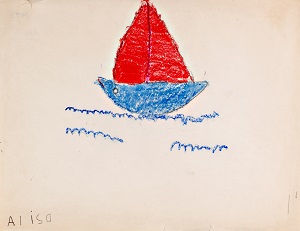
I want my mom’s attention. I know how to get it. I pick up my drawing and I bring it over to her. “Mommy,” I say. “Look what I made.” She looks at my picture and smiles. She tells me that she likes what I made. Her words make me feel special. I believe I’m an artist because my mom says that I am one.
Journaling Tools
A journal can be a tool to prioritize and reorganize your life, bringing you the joy, peace ,and happiness you keep reaching for but never quite find.
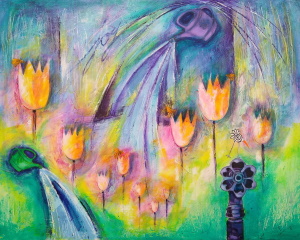
Consider a jar: an empty jar just waiting to be filled. First you add some golf balls to that jar: golf balls right up to the rim. Is the jar full now? Consider adding some pebbles. As you drop the pebbles in the jar, they fill the spaces between all those golf balls all the way up to the rim of the jar. Is the jar full now? Try adding some sand. Watch the sand fill the spaces the pebbles couldn’t fill. The sand fills all these spaces all the way up to the rim of the jar. Is the jar full now? Reach for a tall glass of water and pour it slowly into that jar. See the water fill the tiny spaces between all those grains of sand. Watch the liquid as it makes its way up the sides of the glass as it reaches towards the rim. Now the jar is full. Often our lives are a lot like this jar: we keep filling it up with stuff. But, unlike this jar, we don’t walk away full. Instead, we walk away empty, and we wonder why we don’t have joy.
Imagine those golf balls are like the most important things in our lives. Everything else that filled that jar took up space but, like in our lives, these other space takers are not always important or necessary. Maybe peace and joy is found when we figure out how to toss out all those space takers in our lives? Maybe some of our plans, and even some of our old hopes and dreams, need to go. Maybe they are just taking up space that doesn’t need to be filled? Maybe those space takers are robbing our joy?
Are you having trouble letting things go? Is there just not enough time to do everything you want to do? Are you having trouble deciding what to let go and what to hold on to? The road to joy involves figuring out your priorities, letting go of some of your plans, and embracing what’s important. You can’t have it all and have joy.
Are you having trouble letting things go? Is there just not enough time to do everything you want to do? Are you having trouble deciding what to let go and what to hold on to? The road to joy involves figuring out your priorities, letting go of some of your plans, and embracing what’s important. You can’t have it all and have joy.
Keeping a journal can help you draw the line at the place where the space takers start robbing your joy. Using a journal can help you keep track of your story, and it can become a tool that helps you discover the misguided priorities in your life. As you use this tool to reflect on your life, you will discover its incredible power to bring more joy into your story. You don’t have to publish your story or share it with anyone if you don’t want to. What you share about your spiritual life can stay right inside your journal just for you.
Grab a pen and a simple journal and take a reach for something really satisfying. Writing in a spiritual journal is a choice that will allow you to experience greater joy. Some things need to be let go of in all our lives. Writing in your journal will help you make choices about what pebbles, sand and water you will allow in your jar each day. Create a space to be happy and use it. The laundry can wait, and maybe today just isn’t the day to clean the toilet. Maybe today is the day you put your pen to the paper and make more space for joy?
Good Work
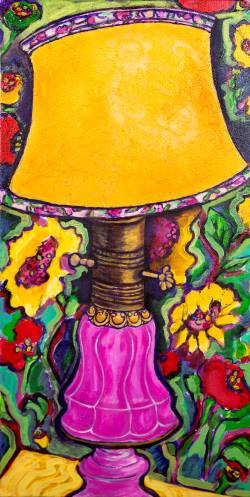
Stuff Long Forgotten,
Age 47
People might not notice my work until I’m dead. That’s how it often goes. I just made one of my best paintings ever. It has sat on the windowsill, next to the dinner table, for 3 weeks now. No one has even commented. They love me and they respect me too. There’s just a piece of me (an important piece) that’s lost on them. It’s probably a gift (their indifference) because I have to validate myself instead of getting the validation from outside me. I’ve gotten to the point when I know when my work is good: even if everyone around me is oblivious.
Transforming Work
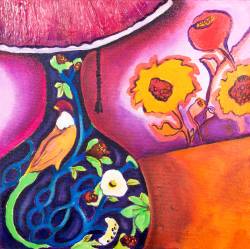
Oriental Vase,
Age 47
My mom could always make the craziest colors and patterns work. She had a unique eye. It was lost on many around her, but it was not lost on me. She made a point of passing it on to me and I am grateful. My mom was a fascinating and talented woman with passion. Now, that’s me.
"My Business" Work
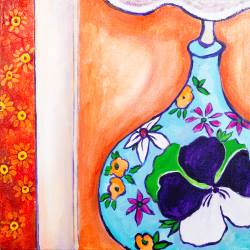
Big Belly Vase,
Age 47
It isn’t really blue, but I paint it blue anyway. The wall wasn’t orange either, but I can. Big Belly Vase is my business, not yours. Close your eyes if you don’t like what you see.
Thick Skin Work
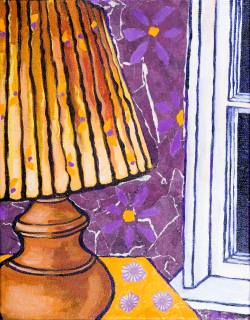
Orange Vase,
Age 47
I know I don’t draw really well. I know there are many artists who blow my work out of the water. Should that stop me? I’ve had many teachers tell me I have a knack with color. Isn’t that what painting is about anyway? And seriously, even if I am a “Half Talent” at best (but painting brings me peace and joy) shouldn’t I create and share. Maybe other people, regardless of their “talent” will create, share, find peace and joy along with me! What more could be the point of it all? We make it all about talent. Creating is only for the “artists” is the message even inside elementary art classrooms. How sad is that. You might say my Orange Vase is ugly. Well, I had a fabulous time making it and someone else is going to make art today because I shared. Neither if it’s beautiful or ugly is the point.
“Half is talent. Half is thick skin.”
Author Unknown
Spark Work

Peacock Collage,
Age 46
I remember the peacock feathers. As a child, they were a source of total fascination for me. I loved to touch them and play with them. I am now drawn to them when I see them. A simple peacock feather can spark memories that bring me all the way to being a toddler. It is amazing that something so basic can take me places I haven’t been for 45 years.
Magical Work

Sunflowers With No Pot,
Age 47
Van Gogh painted sunflowers. I’m no Van Gogh but I’m inspired by sunflowers too. You can paint them in a million different ways: interpret them however you’d like. They give you permission to do something brand new.
My painting lets sunflowers grow in the middle of a bedroom. There is no pot to hold them. They magically grow out from the floor. I am more interested in how I feel about this space than I am interested in describing it accurately. This was a time when I was down, and I felt safety and comfort in my surroundings. Today, I try to use that space to pass that feeling on.
Escaping Work
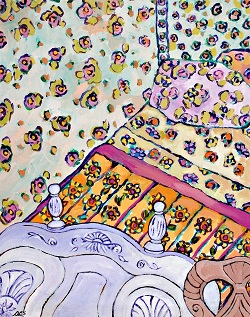
A Bed to Sleep In,
Age 24
It should be no surprise that I hate beds. Even before I lie down, dread creeps in. Nothing brings me comfort. My childhood bed was made for a princess. It had soft cotton sheets, a beautiful antique wooden frame, and a warm floral comforter. I hated it. Constantly exhausted, my beautiful bed was a place of torment. I’d fall asleep to wake up 5 minutes later. Sleep never lasted. My beautiful bed was hell. Finding God in the dark, emptiness of the night was my only hope of escape.
Liminal Work

Space Travel,
2019
Sharing Your Journey
What are your earliest memories? Briefly list and describe three early memories. Select one memory from the list and write down whatever it brings to mind. Include sensations, time frame, images, smells, emotions, and details associated with this memory.
Consider the ways your early memories have shaped you. In what ways have your good childhood memories made you stronger spiritually, physically, and emotionally? How have childhood memories interfered with your desire to live a life of peace and integrity? Use your early memories to make connections between your past and your present experience. Write down what you uncover. Share your discoveries with a trusted counselor or friend. Don’t be surprised if sharing shows you that someone has been where you are. Expect to encourage and be encouraged. Enjoy the benefits of beginning to share your story.
LOREM
